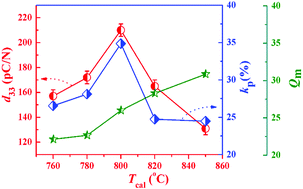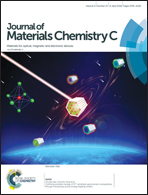Enhanced insulating and piezoelectric properties of 0.7BiFeO3–0.3BaTiO3 lead-free ceramics by optimizing calcination temperature: analysis of Bi3+ volatilization and phase structures
Abstract
Herein, we report the significantly enhanced insulating and piezoelectric properties of a lead-free ceramic in a simple composition of 0.7BiFeO3–0.3BaTiO3 (0.7BF–0.3BT) without any addition of MnO2 or other dopants, which is derived by fine-tuning the calcination temperature (Tcal = 760 °C, 780 °C, 800 °C, 820 °C and 850 °C). All the calcined powders have a main perovskite phase with R3c symmetry and a small amount of Bi25FeO40 impurity, whose ceramics become a typical R3m and PC coexisting structure at 760 °C ≤ Tcal ≤ 820 °C, and a single PC phase at Tcal = 850 °C. Tcal is crucial to optimize the volatilization, density and phase structure including perovskite symmetry and impurity phase, thereby enhancing the insulating properties and piezoelectric properties. Benefitting from weak Bi3+ volatilization, low number of  , a dense microstructure and appropriate CR/CPC ratio at Tcal = 800 °C, the enhanced insulating and piezoelectric properties of 0.7BF–0.3BT lead-free ceramics are achieved, whose d33 = 210 pC N−1, kp = 0.34, TC = 507 °C, Pr = 40.6 μC cm−2, and EC = 16.4 kV cm−1.
, a dense microstructure and appropriate CR/CPC ratio at Tcal = 800 °C, the enhanced insulating and piezoelectric properties of 0.7BF–0.3BT lead-free ceramics are achieved, whose d33 = 210 pC N−1, kp = 0.34, TC = 507 °C, Pr = 40.6 μC cm−2, and EC = 16.4 kV cm−1.



 Please wait while we load your content...
Please wait while we load your content...